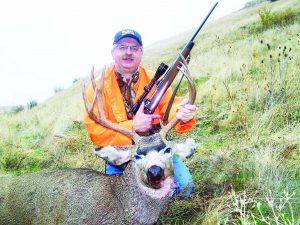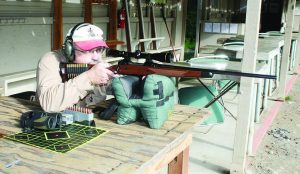by Dave Workman | Senior Editor
A 165-grain .30-caliber Nosler AccuBond bullet with its distinctive white polymer tip propelled by 42 grains of IMR 4895 and a CCI primer leaves the muzzle at more than 2,500 fps and it crosses 200 yards in a nano-second.
I know because that’s the combination that took down my biggest Snake River mule deer buck a few years ago, a hefty 4×5-point animal that kept my freezer full through the winter and actually took three guys and an ATV to get out of the canyon we were in.
The rifle was a Savage bolt-action American Classic with a Leupold scope, and it was zeroed to shoot dead-on at 300 yards. Shooting across Snake River canyon breaks is no close-quarters drill.
It was that experience that convinced me the .308 Winchester has a lot of fine qualities that many American deer hunters have come to appreciate, and others may underestimate. It is most assuredly one of the top five deer hunting cartridges for any number of reasons, but as fall hunting seasons loom and the smell of Hoppe’s No. 9 fills the air in workshops, garages or back porches across the country, I’m going to lay out five things that make this a superb choice for deer hunters.
I say this despite the fact that I typically hunt with a bolt-action Marlin chambered for .30-06 Springfield that is a superb deer stopper.
The .308 Winchester may not be the end-all, be-all cartridge for deer hunting, but it is a winner and for a majority of people and hunting environments, it just might be the best “compromise” caliber.
Number One: Ballistics. The .308 Winchester is a short-action cartridge that has marvelous ballistics. With right factory load or handload, this round can reach out 350- to 400 yards and put the hurt on an eastern or Midwest whitetail, Wyoming muley or Pacific Coast blacktail, provided the shooter does his/her part.

Senior Editor Dave Workman anchored this Snake River buck a few seasons ago. His rifle is a Savage American Classic chambered in .308 Winchester, with a 3-9 Leupold scope.
Within 200 yards, which is more typical in hunting situations than some people might realize, this round in a good rifle will shoot flat, hit hard and deliver a swift, humane termination.
I long ago took a shine to the .308 Winchester as a cartridge because it is easy to load and there are a variety of propellants that make it go “BANG!” with gusto. I prefer IMR 4895 or Hodgdon’s H4895, which are not the same and the loading data is slightly different.
For bullets, I have used Nosler’s AccuBond and Ballistic Tip, the Hornady InnerBond and Speer boattail, all with great results. Sierra makes a 165-grain GameKing soft point that is a sizzler as well, and here’s the reason why: They are all boattail designs with terrific ballistic coefficients; that is, they are shaped with spritzer-type profiles to warp through the air with as little wind resistance as possible and clobber whatever they hit.
Bullet drop isn’t so bad, either. My boattail bullet choices leaving the muzzle at more than 2,500 feet-per-second will drop approximately 10 inches at 300 yards if the rifle is zeroed at 200 yards, shooting 2.5 inches high at 100 yards.
However, if I zero that rifle to shoot 5.8 inches high at 100 yards, I’ll be dead-on at 300 yards.
You can find out all about ballistics by consulting the ballistic tables in the back of any good reloading manual.
No bullet shoots perfectly “flat.” If a bullet strikes within 1-2 inches of where it is supposed to go, that translates to a notched tag.
Number Two: Recoil. For recoil sensitive shooters, the ’06, .300 Winchester or Weatherby magnums or 7mm Remington Magnum can be a handful, but the .308 Winchester by comparison can be a pleasure to shoot. A few years ago, I bought a .30-06 rifle for my brother as a “thank-you” for helping me with some remodeling projects.

Author Workman zeroes his Savage American Classic rifle before big game hunt in the Pacific Northwest.
It’s a great shooter, with a modern recoil pad, but he’s a smaller fellow and recoil is an issue. He subsequently acquired a Ruger bolt-action in .308 Winchester on which he also mounted a Leupold scope, and last fall he anchored a 3-point buck with a shot that astounded me, and that’s saying a lot.
Using my handloads, we had zeroed the gun to hit dead on at 200 yards. He spotted a buck heading uphill in a canyon at about 150 yards and put a round right behind his ear to not spoil any of the meat. He may have also been trying to show off, but who cares? He went home with a cooler full of venison.
With the proper recoil pad – and there are some really lousy recoil pads out there – one can reduce felt recoil in the .308 by a significant amount. I have come to like Kick-EEZ and Limbsaver pads, both made in my home state of Washington. I have fit one or the other to every rifle I own and have yet to be sorry.
Number Three: Availability. The .308 Winchester is something of a universal cartridge, so ammunition is available all over the map. I keep spare cartridges on one of those elastic looped carriers on the stock of my rifle, so when I grab and run, I’ve got at least ten rounds of ammunition. There are also 20 rounds in my truck all season long, along with 20 rounds of ’06, so depending upon which rifle goes along on a hunt, there’s spare ammunition within reach.
Naturally I prefer my own handloads, but in a pinch it is pretty easy to find factory ammo that approximates the ballistics of my own fodder, especially if it is loaded with the same type of projectile found on my loading bench.
If you want to own one, virtually every popular rifle company offers models in this caliber. Winchester (of course), Remington, Savage, Browning, Mossberg, Ruger, Marlin; pick a commercial firearms manufacturer and chances are, there is at least one model in their lineup that is chambered for this popular cartridge. I even have an old single-shot H&R 1871 in .308 with a laminated stock and old Bushnell scope. I recently hauled it out of mothballs and headed to the range, where it still shot to point of aim after all these years.
Number Four: Versatility. The .308 Winchester is a remarkably versatile caliber. You can find bullets weighing anywhere from 110 grains on up to 200 grains, so you match the load to the game.
If you’re trying to reduce the coyote population, a 125-grain pill fired from 400 yards or so will take the yodel out of the dog decidedly. For northern whitetails, I suggest 150- to 168-grain projectiles, and the same goes for mule deer. I prefer the 165-grainer because they just work like gangbusters in my particular rifles and these deer have pretty good body mass. And for western blacktails, bullets in this weight range are strong medicine because you’re shooting at comparatively short ranges most of the time, within 200 yards usually. I’m comfortable with a 150-grain bullet against a blacktail, because they typically aren’t that big.
The .308 also shows up in a fair number of elk camps out west, and for that game I’d go with a 180- or 200-grain bullet with a maximum powder charge (consult your loading manual) for punch and penetration. An elk can have a significant body mass, and I have yet to see one that isn’t capable of moving even when hit if it is only wounded. But that can happen if you gut-shoot an elk with a .300 Winchester Magnum.
Number Five: Weight. It’s been my experience that short-action rifles chambered for the .308 Winchester (and other short-action cartridges, as well) tend to be a bit lighter in weight than long-action rifles. After a long day of lugging a rifle around, trust me, you will notice the difference.
Of course, one can always buy a lightweight “mountain rifle” model in just about any popular caliber, but we get right back to “Number Two” (above). If you think recoil can be hard with a standard field sporter model, pick up a lightweight chambered in ’06 or .270 Winchester and some people will consider the recoil to be just this side of brutal.
A short-action rifle typically allows the hunter to mount a shorter profile scope. There’s another couple of ounces shaved off the carry weight.
If you live in a damp environment, like the Pacific Northwest, you can consider a rifle with a synthetic stock. Those are usually a bit lighter in weight than a wood stock, and especially a laminated stock, and those stocks can really take punishment without showing a bunch of scrapes and dings.
There is no “perfect” or “best” cartridge for deer hunting. The .308 Winchester, ’06, .270- Winchester, .257 Roberts, .30-30 Winchester, and many others have become part of the hunting fabric. The rifle you carry—the one with which you can punch holes in a target and put meat on the table—is the best rifle for you.
Now, before the fall hunting season begins, is the best time to be visiting the range. Make sure that rifle is zeroed, use up last year’s ammunition and get some fresh cartridges, and otherwise get into shape. You may only get one shot all season long. Make it count.



